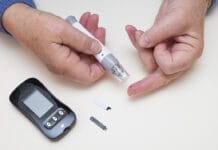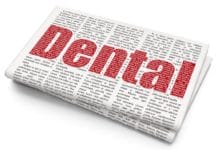Every so often, a patient will admit to rinsing regularly with undiluted 3% hydrogen peroxide. If you’re anything like me, your mind immediately envisions a thick, black, carpet-like tongue coating in the near future. Thankfully, peroxides have been used safely in dentistry since first introduced in 1913 as a treatment for “pyorrhea.”4 When used in a controlled manner, peroxides have several oral health uses and benefits.
The most common peroxides in dentistry are hydrogen peroxide (H2O2) and carbamide peroxide (CH6N2O3), also known as urea hydrogen peroxide.6. When using hydrogen peroxide, it is important to note the grade and concentration. The grade effects what stabilizers and additives the hydrogen peroxide contain and dictates where it may be sold. The concentration is the percentage and strength; for example, the common 3% brown bottle of H202 seen in most stores. The concentration may also be stated as parts per million (ppm). Carbamide peroxide has a shorter shelf-life than hydrogen peroxide, but the shelf-life of any peroxide can be extended with refrigeration.1
Whitening with Peroxide
By far, the most popular use of peroxides in dentistry is for teeth whitening. As a weak acid with strong oxidizing properties, hydrogen peroxide oxidizes pigments on teeth to change their color. Oxidizing removes electrons that hold atoms together forcing stain molecules to come apart.6
Whitening may be attained by rinsing with hydrogen peroxide. One study showed that using a mouthwash with a 1.5%-2% concentration of H2O2 for 12-weeks resulted in a similar level of whitening as compared to 2 weeks of a 10% carbamide peroxide gel.5
“Walking” bleach, also known as custom-fitted bleaching trays and “power” or in-office bleaching treatments, have also been proven safe and effective teeth whitening options. In-office bleaching uses heat or light to accelerate the decomposition of hydrogen peroxide to release oxygen.
The most common formulations in dentistry are 35%-38% hydrogen peroxide, 3%-10% stable hydrogen peroxide gel, or 10%-15% carbamide peroxide. A 10%-15% carbamide peroxide gel releases a 3%-5% hydrogen peroxide concentration.4,10
Gingival irritation and/or increased temporary dentinal sensitivity are the most reported adverse effects after using whitening products.4 Custom-fitted trays that do not fit well may cause post-treatment discomfort from gingival erythema or mucosal sloughing.10 Power or in-office bleaching must always be monitored closely by a dental professional.
If hydrogen peroxide can enter the pulp from restoration leakage, exposed dentin, or enamel fractures, it may cause inflammation of the pulp or loss of tooth vitality when combined with light/heat in as little as four 30-minute sessions with 33% H2O2.4,10
Peroxide Mouthwash
There are two types of mouthwash, according to the American Dental Association − cosmetic and therapeutic. Cosmetic rinses temporarily control bad breath but do not have chemical or biological applications. Therapeutic rinses contain active ingredients like cetylpyridium chloride, essential oils, fluoride, or peroxide. These active ingredients help to control or reduce gingivitis, plaque, halitosis, and tooth decay.5
Over-the-counter mouthwash products will contain 1.5%-3% hydrogen peroxide. The recommended at-home dilution for a hydrogen peroxide mouthwash is half water, half 3% H2O2 rinsing for one minute up to four times daily.8
Please note that adverse reactions such as chemical burns to the oral mucosa have occurred with rinsing for more than two minutes with 3% hydrogen peroxide, and improper use of H2O2 with a concentration >3% can cause epithelial necrosis.9
Baking Soda and Peroxide
Baking soda or sodium bicarbonate (NaHCO3) is often paired with hydrogen peroxide in oral hygiene products. These products generally contain 1.5%-3% hydrogen peroxide concentrations. Baking soda is thought to have a synergistic effect with hydrogen peroxide accelerating decomposition, oxidation, and may help to disrupt gram-negative cell membrane to allow hydrogen peroxide into the cell. Studies show using baking soda at higher levels allows using lower levels of hydrogen peroxide to produce the same antimicrobial effect as higher concentrations of hydrogen peroxide alone.4, 10
Peroxide, Gingivitis, and Periodontitis
The FDA has approved the use of hydrogen peroxide as a temporary oral debriding agent. Hydrogen peroxide can break through the slime barrier that protects biofilm and destroys bacterial cell walls. It releases oxygen and creates an environment unfit for anaerobic bacteria to survive.4,8
Bacteria that are susceptible to H2O2 by itself or in combination with baking soda include Actinobacillus actinomycetemcomitans, Haemophilus aphrophilus, Eikenella corrodens, Capnocytophaga gingivalis, Mycoplasma salivarium, Actinomyces naeslundii, Actinomyces viscosus, Streptococcus salivarius, and Streptococcus mutans.4
In a study using 1.5% hydrogen peroxide mouthwash, orthodontic patients in the mouthwash group showed significantly fewer sites of plaque and gingivitis than the placebo group with a lack of any adverse soft tissue effects.10
In another study of special-care needs patients, carbamide peroxide 10% gel was used in a custom-fitted tray worn nightly. Due to the ability of CH6N2O3 to increase salivary and plaque pH and reduce the presence of damaging oral bacteria, this application of carbamide peroxide gel was found to be a highly effective treatment in cases of compromised oral health. This includes those with special-care needs, elderly patients, those undergoing cancer treatment, and those with severe xerostomia.3
Hydrogen peroxide can affect both gram-positive and gram-negative bacteria by damaging cells and delaying cell division but is only helpful in the treatment of periodontal disease with mechanical access to subgingival pockets.4 In a study of 45 patients with mild-moderate chronic periodontal disease, one group rinsed with 0.2% chlorhexidine acetate (CHG) twice a day for 10 days, and a second used 1.5% H2O2 twice a day for 10 days. The CHG ultimately proved better at reducing gingival index, pocket depths, and clinical attachment loss.7
Safety Considerations
Black hairy tongue (BHT) comes to mind for any dental hygienist when a patient mentions regular oral use of hydrogen peroxide. It is a benign medical condition characterized by elongated filiform lingual papillae with a carpet-like appearance that present on the dorsal surface of the tongue. Despite the name, it can appear black, brown, yellow, green, blue, or colorless.
Regular undiluted rinsing with hydrogen peroxide or overuse of mouthwashes containing sodium perborate, sodium peroxide, or hydrogen peroxide is directly associated with the development of BHT. Conversely, it may be used to treat the condition when diluted with water or baking soda.
Also, gentle debridement with a soft toothbrush or tongue scraper is recommended to promote the desquamation of the hyperkeratotic papillae to promote healing. The most important factor is discontinuing the offending agent which may also include factors like smoking, excessive black tea or coffee, medications, and poor oral hygiene.2
High concentrations of hydrogen peroxide at 30% with prolonged use have been shown to reduce microhardness of enamel and dentin by reducing the ratio of calcium and phosphorus leading to demineralization.10 Enamel etching that allows opportunistic microflora into enamel can occur at 30 hours of use with high-level peroxide and softened enamel can result from 12 hours use of 10% carbamide gel.4
Ultimately there is good evidence for safe daily use of hydrogen peroxide at low concentrations over long periods, however, with high concentrations and prolonged exposure, oral soft and hard tissue damage can occur.10 Using 3% (or less) hydrogen peroxide as instructed is safe to use without any major adverse effects or co-carcinogenic activity.4
Before you leave, check out the Today’s RDH self-study CE courses. All courses are peer-reviewed and non-sponsored to focus solely on pure education. Click here now.
Listen to the Today’s RDH Dental Hygiene Podcast Below:
References
- Concentrations of Hydrogen Peroxide.Using Hydrogen Peroxide. 2018. Retrieved from www.using-hydrogen-peroxide.com/Concentrations-of-hydrogen-peroxide.html.
- Gurvits, G.E., Tan, A. Black Hairy Tongue Syndrome.World Journal of Gastroenterology: WJG. 2014 Aug; 20(31): 10845–10850. Retrieved from https://www.ncbi.nlm.nih.gov/pmc/articles/PMC4138463/#,%2010.3748/wjg.v20.i31.10845.
- Lazarchik, D.A., Van Haywood, B. Use of Tray-Applied 10 Percent Carbamide Peroxide Gels for Improving Oral Health in Patients With Special-Care Needs.The Journal of the American Dental Association. 2010 June; 141(6): 639–646. Retrieved from https://jada.ada.org/article/S0002-8177(14)64739-5/abstract,%2010.14219/jada.archive.2010.025
- Marshall, M.V., Cancro, L.P., Fischman, S.L. Hydrogen Peroxide: A Review of Its Use in Dentistry. Journal of periodontology. 1995; 66: 786-96. Retrieved from https://aap.onlinelibrary.wiley.com/doi/10.1902/jop.1995.66.9.786
- Oral Health Topics: Mouthwash (Mouthrinse).American Dental Association. August 29, 2019. Retrieved from www.ada.org/en/member-center/oral-health-topics/mouthrinse.
- Carbamide Peroxide. National Center for Biotechnology Information. PubChem Database. Retrieved from https://pubchem.ncbi.nlm.nih.gov/compound/Carbamide-peroxide
- Rashed, H.T. Evaluation of the Effect of Hydrogen Peroxide as Mouthwash in Comparison with Chlorhexidine in Chronic Periodontitis Patients: A Clinical Study.Journal of International Society of Preventive & Community Dentistry. 2016;6(3): 206–212. Retrieved from https://doi.org/10.4103/2231-0762.183114
- Cosgrove, E. Hydrogen Peroxide Gums and Teeth Treatment. Colgate. www.colgate.com/en-us/oral-health/life-stages/adult-oral-care/hydrogen-peroxide-gums-and-teeth-treatments
- Boras, V.V, Brailo, V., Rogulj, A.A., et al. Oral Adverse Reactions Caused by Over-the-Counter Oral Agents.”Case Reports in Dentistry. 2015; 2015(Article ID 196292). Retrieved from www.hindawi.com/journals/crid/2015/196292/
- Walsh, L.J. Safety Issues Relating to the Use of Hydrogen Peroxide in Dentistry. Australian Dental Journal. 2000; 45: 257-269. DOI:10.1111/j.1834-7819.2000.tb00261.x














